FAQs about Stony Coral Disease Diagnosis
(Pollution/Poisoning, Lighting...)Related Articles: Coral Pests and Disease; pests, predators,
diseases and conditions by Sara Mavinkurve,
Quarantine of Corals
and Invertebrates, LPS
Corals, True or Stony Corals, Order
Scleractinia, Propagation for Marine
Aquarium Use,
Related FAQs: Stony Coral Disease 1, Stony Coral Disease 2, Stony Coral Disease 3, Stony Coral Disease 4, Stony Coral Disease 5, Stony Coral Disease 6, Stony Coral Disease 7, Stony Coral Disease 8, Stony Coral Disease 9, Stony Coral Disease 10,
Stony Coral Disease 11, Stony Coral Disease
12, Stony Coral Disease 13,
Stony Coral Disease 14,
FAQs on Stony Coral Disease by Category: Diagnosing:
,
Nutritional, Social (Allelopathy),
Trauma,
Pathogenic (Infectious, Parasitic, Viral)
Predatory/Pest,
Treatments
FAQs on Stony Coral Disease by Family: Acroporid Disease, Acroporid Disease 2, Acroporid Disease 3, Acroporid Disease 4..., Caryophyllid Disease, Caryophyllid Disease 2..., Elegance Coral Disease/Pests, Dendrophylliid Disease, Faviid Disease, Faviid Disease 2, Fungiid Disease, Mussid Disease, Mussid Health 2, Poritid Health, Trachyphylliid Disease, Trachyphyllia Disease 2,
FAQs on Stony Coral Disease by Type: Brown Jelly Disease, RTN,
|

|
|
Moray Eels and Coral
/BobF 9/14/19
Hello Crew,
<Iishan>
Does the mucus from moray eels inhibit coral growth?
<Mmm; have not come across such statements... Marco?>
I have a 32 gallon aquarium with live rock, live sand, a small eel and four SPS
corals. WWM
crew identified this eel as a Gymnothorax australicaola many years ago. It is
about 8 or 9 inches long. The corals are two Montipora and two Acropora.
<Stony corals, Acroporids in this case, are easily influenced by metabolite
accumulation...>
I am trying to learn why the corals are dying. If the water chemistry, lighting
and temperature are OK, could the eel be causing a problem for the corals? I
feed it a small fish about once every two weeks. The nitrate and phosphate
levels are undetectable.
<Numbers please, for what you mention, lighting, feeding>
I have a professional do maintenance on the aquarium once a month and he does
not know why the corals are dying. He suggested that the mucus could be the
problem.
Thank you,
Iishan
<Possibly... Bob Fenner>
Moray Eels and Coral /Wil
9/14/19
Hello Crew,
<Hello Iishan, Wil this morning>
Does the mucus from moray eels inhibit coral growth?
<Not usually>
I have a 32 gallon aquarium with live rock, live sand, a small eel and four SPS
corals.
<Not the ideal water volume, do you have a sump-refugium?>
WWM crew identified this eel as a Gymnothorax australicaola <australicola> many
years ago.
It is about 8 or 9 inches long. The corals are two Montipora and two Acropora.
I am trying to learn why the corals are dying. If the water chemistry,
lighting and temperature are OK, could the eel be causing a problem for the
corals?
<The only thing that I’d blame the eel for, is that it may be toppling the
corals while swimming or at feeding time and this may be stressful for your
SPS.>
I feed it a small fish about once every two weeks. The nitrate and phosphate
levels are undetectable.
<Do you have a good protein skimmer? Eels are messy eaters that produce a lot of
waste so, frequent water changes are required to guarantee the cleanliness of
the water needed by corals, especially in reduced water volumes.>
I have a professional do maintenance on the aquarium once a month and he does
not know why the corals are dying. He suggested that the mucus could be the
problem.
<I don’t think the mucus produced by the eel is the reason of the inhibited
coral growth, if your lighting, nitrates and phosphates are adequate, it must
likely be an alkalinity and/or calcium issue, what are the levels on both?...
you didn’t mention the ph level either.>
Thank you, Iishan
<You're welcome. Wil.>
|

 |
|
Re: Moray Eels and Coral 9/17/19
Sorry for the delayed reply, Bob! I am not aware of any negative impact of moray
eel mucus on coral growth and have seen stunning systems with corals and moray
eels, although those tanks were large and heavily filtrated. I suspect water
quality and/or microbiology being the culprit here. Cheers, Marco.
<Thank you Marco; this is the experience Wil and I related. Cheers, BobF>
|
|
corals dying; General input in, general output out
6/30/17
<5.6 megs...>
Help
Rich here
<RMF here>
My corals are dying. I have a 180 gallon setup that has been running for six
years. It was FOWLR and some inverts: hermits, cleaner shrimp, small
snails. Last Fall I put two live rocks with anthelia in the tank. They did
great. slowly, over six months, I added a few mushrooms, Zoanthids, trumpets,
Duncan branch colony, a dragon soul and an Acan lord. Everything was
doing fine, growing, until I added a mummy eye chalice from a LFS.
<Mmm; could be just coincidence>
My water parameters are stable: zero ammonia and nitrites, nitrates 2 ppm, ph
8.2, temp 77 degrees, KH 11, calcium 420.
<Have some HPO4? About three times [Mg] than Calcium?>
Three sicci circulation pumps in the main display, and reef breeders led lights.
I do 20% water changes every 10 to 14 days with RODI water.
The mummy eye had a small area on it that looked like some of the "skin" was
starting to peel. I should have never bought it. Over about three weeks it
started to die off . I brought it back to the LFS and they cut off the dying
parts and dipped it.
<Worth trying>
After going back in the tank it continued to die off over a few days. It was
removed, and now, about six weeks later, a Zoa garden that I have had for seven
months, my Acan and dragon soul are all going thru the same process. I am also
starting to see some small patches of green algae in the tank for the first
time. I have attached two pics.
I think I waited too long for the Acan but I need help to save what I can. Any
suggestions? Thanks you.
<The usual "punting" ideas of overdosing iodide-ate, use of simple sugar
(glucose likely). All gone over on WWM. See the search tool (on every page), or
learn to/use the indices. The large/r issue/s could involve some other aspect/s
of water quality, "something" missing critically, simple/r allelopathy... there
are a few approaches to discounting these... Massive water changes/almost
clean-outs, use of chemical filtrants, addition of refugiums/sumps with massive
DSBs, macroalgal culture on RDP... So; a bunch to state that cannot be easily
re-keyed daily.
Bob Fenner>
|
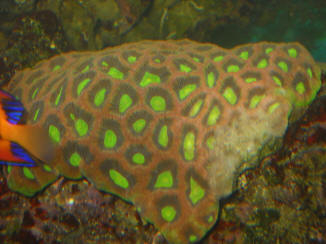
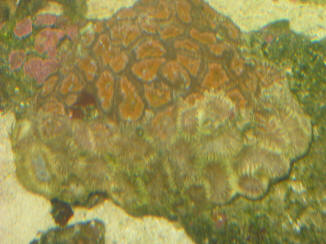 |
|
Acropora black bugs 5/4/16
Hey I was wondering if someone might possibly have some info about a problem
I am having. I have black "bugs" on some Acropora.
<Happens>
I have treated my tank with interceptor and it didn't kill them.
<Interesting... might want to try a biological predator... some small
wrasses, pipes...>
Killed off a lot of other stuff. Also I have dipped these corals in Coral
Pro RX, Revive, Bayer at triple strength and nothing has worked.
<Strange... and frightening>
They seem indestructible. I am not considering drying everything out.
They only seem to affect the across. But I left the tank empty of those for
a few weeks and when I place a frag in they have come right back. I am not
sure if these bugs can survive on detritus or other food and maybe stick
around even for prolonged periods of time.
Any help you might be able to offer would be greatly appreciated.
Thank you, Brad V.Greensboro, NC
<I'd REALLY like you to collect some, take their pic under magnification...
and send along for Identification.
Otherwise, re bio-controls, please read here:
http://www.wetwebmedia.com/AcroBugF.htm
Bob Fenner>
Re: Acropora black bugs 5/4/16
This is the best I have been able to get so far. Will keep trying
though.
Also here's a video but not great quality. Acropora bugs! Not red bugs
<Mate.... these look like flatworms... BobF>
|
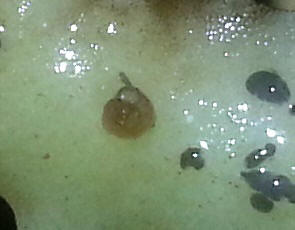 specks?
specks? |
|
Re: Acropora black bugs
5/4/16
the grey spots?
did you see the video?
<No... the link doesn't work... practice sending it to yourself and re-send>
do they swim like that? I know the bites look the same as flatworm bites.
Thank you for your patience.
Re: Acropora black bugs 5/4/16
Acropora bugs! Not red bugs
<?>
Re: Acropora black bugs 5/4/16
I sent the link ... didn't get it? Here goes again
<... worthless. Do you make these blurry messes as copepods, amphipods. GET
a scope mate>
https://www.youtube.com/watch?v=fGq7j3k0zmw&feature=youtube_gdata_player
Re: Acropora black bugs 5/4/16
Do you kiss your mother with that mouth?
<Mmm; no; she passed on/croaked about a dozen years back>
|
|
STN issue on Acros 4/13/16
Hello Bob and Crew,
<Howdy Tann>
Thank you in advanced. I have a two part issue unfortunately.
<Go ahead>
The first issue is in regards to my SPS frag tank. I have a
48"x48"x12" frag tank that I've had for about a year now. I like to
grow out my corals before placing them in my display.
<Neat>
I have changed from 4x Radion G2 to 8x T5s 4 weeks ago, because I
was having trouble getting good coloring and I've heard that T5s would be
better for this issue. Therefore I wanted to try it out myself. I originally
had the T5s 16" above my water line, and then last week I moved it down to
12".
<Mmm; do/did you measure PAR/PUR before the switch, on install and lowering
the current fixture?>
The top of my large colonies are about 5" below the waterline and I'm
getting par at about 210 now (10% increase although I think my apogee par
meter is not calibrated correctly so it may be giving me false readings).
<Ahh; I see>
Recently I've noticed better coloring, but also STN at the base of 4 of my
corals just a couple days ago. Including my largest colony of Bali shortcake
Acros which is about 10"x6" large. I've attached photos for you to see.
<I see them>
My parameters are as follows and they’ve been pretty stable:
Alk: 8.9
Cal: 410
Mag: 1380
Salinity 1.27
Temp 76-79
Phosphate: I've been getting separate readings on my Red Sea test and on my
digital Hanna checker test. I'm not sure which one to trust as they both
greatly vary in readings.
<But.... there IS some detectable HPO4 I trust>
Do you think it's the lighting?
<This is the most reasonable; recent change>
Should I leave it in place or do a dip in iodide with glucose and lower
salinity?
<I would add the iodide (triple dose every three days, three times) to the
system, as well as the sugar; and lower the spg a thousandth>
The second is issue is with Cyano, which could be affecting the Acros I was
talking about.
<Yes; or vice versa... the condition, whatever is allowing the apparent STN
may be fostering BGA growth>
I've been battling a bad case of Cyano as well for the last 4-5 months
and I haven't been able to pinpoint the problem. I do bi-weekly water
changes of 20% and I also run a phosphate remover.
<I'd remove this... for now.>
I have 3x EcoTech mp40 Vortechs for flow running at 30%. At first I thought
it was my eggcrate, as I read that some of them leech phosphate and
other chemicals.
<? Not as far as I'm aware... they're Styrene>
So I spray painted new ones with paint suited for aquariums. Could it be the
Cyano that's affecting the Acros?
<It could be; yes>
It mostly covers the eggcrate and any rock, but they also cover the edges of
where the Acros encrust. I've attached some photos, you can even see some on
the base of the Acro that's bleaching.
Any advice would be greatly appreciated for the bleaching and the Cyano.
Thanks
again.
<As stated, the treatment in place, removing the GFO (I take it) and
patience. Do report back. Bob Fenner>
|
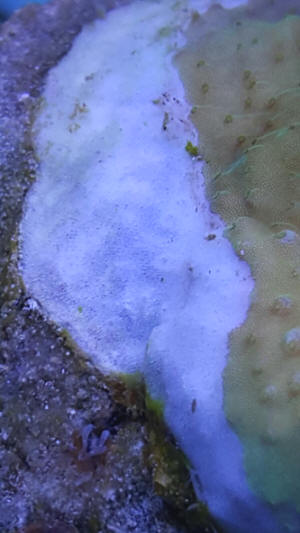
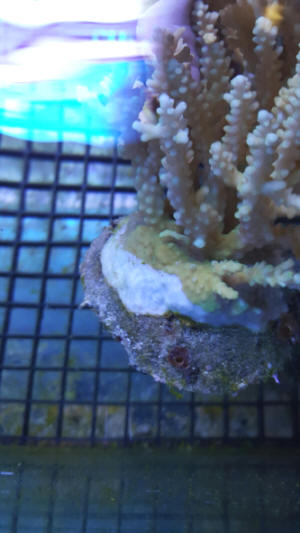
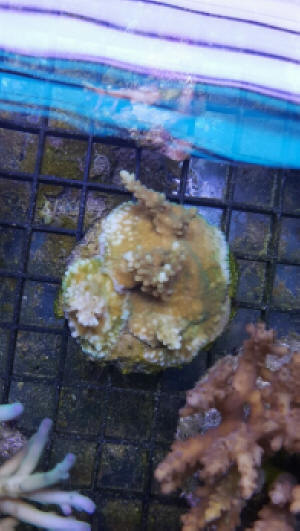
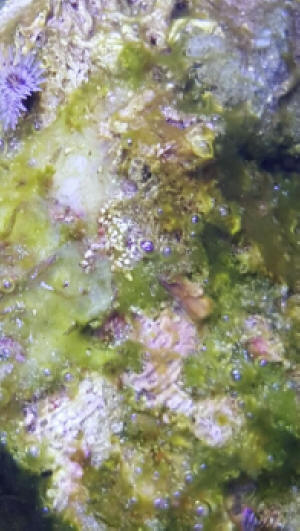 |
|
Corals dying?
10/16/15
Hi we have a 50 gallon salt water tank with a couple of corals. In the past
you have been helpful in our attempts at maintaining a tank, but now we have
some ailing corals. Pictures are attached.
<Mmm; something wrong here; starved?>
We have razor LED lights set to 35% W + 55% B for 7 hrs/day and are getting PAR
readings in the 60-90 range at the corals (depending on the orientation of the
sensor).
<A bit low... I'd "move them up" to shallower water till you were at 100 plus>
These pictures were taken in the evening after the lights had started to
progress back to night (they go to 0 at night), so the
pictures are more blue than the day. We do weekly 5% water changes and have
measures that are stable:
pH = 8.3
Ammonia < 0.2 mg/L
Nitrite = 0 mg/L
Nitrate < 10 mg/L
Phosphate <0.15 mg/L
Calcium > 420 ppm
Alkalinity > 15 dKH
Our cup coral was starting to retreat from its sides so we started turning up
the lights. When it hit 50% W + 50% B, we spoke to someone at our local
saltwater fish store who suggested that the W was too high and we have turned
the W back down. But our cup started retreating massively and now our (elephant
ear?) mushroom coral (which had been extremely healthy)
started to become covered with the same dark algae.
<Trouble.... have you felt this algae? Is it very slimy? Could be that BGA
poisoning is a factor here>
The areas covered with algae are very hard (I know not to touch the soft coral
parts).
Thank you
David and Laura Redish
<Mmmm; well; something not mentioned is trouble here. Do you use chemical
filtrants? What do you feed these corals? What other life is present?
Bob Fenner>
|

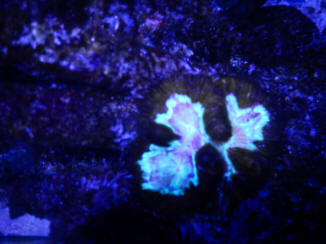 |
|
Re: Fwd: Corals dying?
The corals were doing better until we turned the lights up.
<Ah, I'd "turn them back up"; as prev. stated>
We turned the lights up at 2% per week. But turned it back down when they
started to shrink. But now they're shrinking fast.
Algae is not slimy at all. Generally feels more like rock than slimy algae. It's
as if the corals are simply shrinking.
<I'd still be using GAC, Polyfilter, spiffing up your skimmer, CHECKING
REDOX.... READING on WWM re toxic Algae and its control>
Other life in the tank: 2 clown fish, 1 one-spot foxface rabbit fish, 1 blue
Chromis,
<Social species>
1 Hawkfish, plus small generally good stuff hidden in our rocks - small
feather-dusters, a few of those strawberry anenomes,
<Stop! There is good reason to be concerned re these and....>
some hidden yellow sponges
<these sponges as sources of allelopathy. See the search tool on every page on
WWM? Use it re these animals and the term>
under the rocks, but nothing near either large coral. (Is a very mature tank,
been around for more than six or seven
years.) None of the other life looks unhealthy. Fish all look great.
We feed the tank a small cube of mysis shrimp daily which gets eaten by the
fish. Is there something more we should be giving the corals?
<...? Yes.... STOP writing and start READING>
We haven't fed them for years. The elephant ear coral was healthy until very
recently (>5 years).
Re: BGA poisoning. We don't see anything slimy on the walls of the tank or the
rocks, but I have been noticing what looks like dust or paint on the top of the
tank, at the juncture of the water and the air. It's very thin and fine and I've
tried to scoop it out, but it just dissipates back into the water. If
there was BGA poisoning, what could be done about it?
<....? You're joking? Instead of READING>
I'm not sure what you mean by chemical filtrants.
<....>
We have a canister filter, which we change regularly every 5-6 weeks.
Nothing has changed in that (in terms of slimy algae or anything). Algae and
worms and snails in that appear normal.
thanks
|
|
Frogspawn issues
I noticed on Euphylliid health on your website about pests and parasites and
different solutions. I have not noticed any hitchhikers. The thing I
noticed that my nitrates are high
<How high is high?>
and that I changed over to a max gyre wave maker and ever since that I noticed
the frogspawn respond differently in that it has not all bloom as nice as
before. The wave is not so high to put a lot of current on the frogspawn section
that is being effected. These are a few more different pics that might
be able to help with my issue.
<See some dead heads... long since>
Also I noticed last night a small piece of frogspawn tips on the sand bed.
<Happens; a type of "bail out".... specimen-saving behavior.... escape mechanism
from poor conditions locally. You need to find out what these "poor cond.s"
are... Too little of something/s, too much of...?>
Could it be a fish picking at it.
<Doubtful; Euphylliids/Caryophylliids aren't very palatable... too stinging when
healthy>
I have a coral beauty, yellow tang, blue throat trigger bi color blenny and a
melanarus wrasse. Can I send you a video of my tank and maybe that would be more
helpful?
<You can send a link to the video you post on the Net; but again;
something/s wrong w/ the environment here (the list of possibilities is very
long).... When, where in doubt, large changes.... water changes, replacing
substrate, a good deal of new live rock.... best perhaps moving the colony to
some place new that's established (another system)....>
As I said before this frogspawn is about 20 yrs old. It is or was pretty hearty.
Thanks again for your response. I much appreciate it
<I'd be reviewing the environmental diseases of Scleractinians, the
Families therein; posted on WWM.
Bob Fenner>
Frogspawn issue
Oh yeah I forgot. I also use revive coral cleaner
<Don't know much about this>
when I introduce any new corals which everything else is doing real good other
than a section of the frogspawn. Also how would I administer iodide-ate
and hexose sugars?
<See/Read on WWM re... the search tool....>
Do I take the coral out or dose the tank?
<The latter likely>
Thanks,
Vasilios
<Welcome. BobF>
Re: Frogspawn issues
Thanks for the quick response
<Ah, welcome>
|
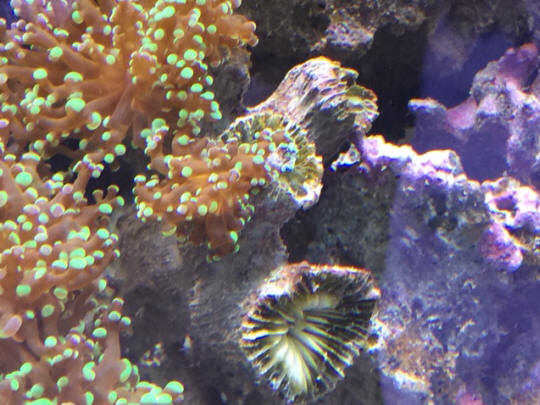 |
|
Re: Frogspawn issues
Hello Mr. fennel. I forgot to mention that I have a purple lobster also a blue
and orange Linckia and yellow mesh starfish. Would they be an issue with the
frogspawn?
<Mmm; not likely. They might be crawling over the colony, but shouldn't result
in the dead areas shown in your pix>
I have had them for a couple of years without problems
Thanks,
Vasilios
Re: Frogspawn issues
Nitrates is 75
<MUCH too high. For reef systems you want to keep [NO3] under 10 ppm maximum.
SEE/READ on WWM re nitrate control.
http://wetwebmedia.com/nitratesmar.htm
and the linked files above. Bob Fenner>
|
|
Problems with online ordered corals
4/10/15
Hello All,
<Vinh>
I hope that everything is well on your side.
<Yes; thank you>
I recently made my first attempt at ordering corals online, and they took bit
longer than anticipated to arrive, about a 24 hour transit because of delays.
<Not atypical; plus who knows how much time in the bag>
I finally received several specimens, but I noticed some problems with some of
the corals that were shipped almost right away. This is how they had arrived.
The torch coral has one dead head.
<See this>
One of the LPS has significant tissue damage, not sure what the cause is.
Another LPS has bleached spots.
My Acropora carduus is bleaching on the tips.
<And all of these>
To try and contain the spread of the damage, should I cut off the parts that are
affected?
<I wouldn't do this... not just yet... Instead the iodide and simple sugar/s
treatment gone over on WWM>
Will this help?
<Not likely.... right now... more probable to cause further stress, troubles>
I've attached some photos for your consideration. I used the recommended
acclimation method from WetWebMedia
as well and they are currently in a quarantine system.
<Ah good.... again, iodide-ate and hexose carbohydrate; perhaps dropping the
spg. a thousandth to induce uptake>
Please let me know what your recommendations are.
<As stated. Bob Fenner> |
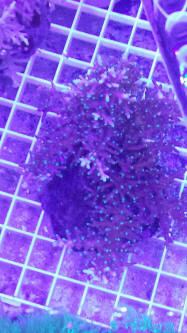
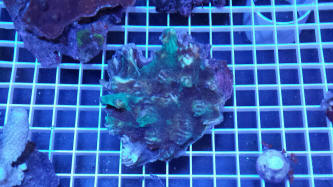
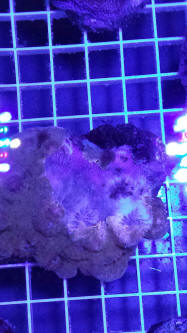
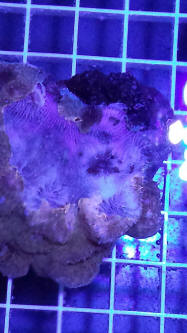 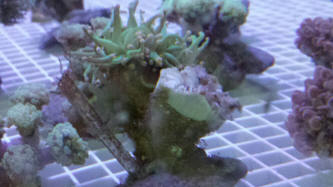 |
Re: Problems with online ordered corals
4/10/15
Hello Bob,
Thank you for your kind reply. I'm terribly sorry but I've done a search on
your website, as well as on Google, but I can't seem to find the article
regarding the directions for performing this treatment.
<Mmm; try the search tool at the top of every page: "Corals Iodine", "Corals
Sugar", then the second search tray to the right w/ just the Iodine or Sugar
word in it. Oh! Tried out myself... some here:
http://www.wetwebmedia.com/iodf2.htm >
I've read through many pages of your FAQs today that have suggestions to add
iodide and a simple sugar, but I was hoping that you had a page with
directions?
<Mmm; not as far as I'm aware>
Would this treatment be performed as a dip?
<Best on the way in from the source. These mat.s are part of my S.O.P. for
the wholesale and collecting sides of the trade>
If you would be able to point me to the right page, (maybe I'm performing
the wrong search) that would be very much appreciated.
<Welcome. BobF>
Re: Problems with online ordered corals
4/11/15
Hello Bob,
<Vinh>
Thanks for sending me the link so much, you and your crew are so dependable and
your advice is always appreciated. I've gone through the page, but I do have two
questions if you don't mind.
1. I acclimated the corals on late Weds. night so they haven't been in the
system for more than 48 hours yet. When should I perform this treatment?
<ASAP>
Right away or wait until the corals settle in a little more.
<Now>
2. How often should I perform this as I read on WWM, that moving the corals 3-4x
per week will surely kill them.
<Doesn't help them to be moved for sure; esp. if not stabilized/healthy.
See the Stony Coral Health FAQs on WWM for much more. Bob Fenner>
Re: Problems with online ordered corals 4/11/15
Also I picked up SeaChem Iodide and glucose from the grocery store like you had
suggested.
<Ah good. You'll be able to see "results" in a few hours.... really. BobF>
|
Re: Problems with online
ordered corals
4/13/15
<Vinh; pls reduce your image file sizes by an order of magnitude and re-send
all>
Re: Problems with online ordered corals
4/13/15
Here you go.
Please let me know if this is better.
<Is; but see our limits re... in "how to write us">
Hello Bob,
I was able to stop some of the RTN on the corals with the treatment
suggested, but some of the corals have gotten worse unfortunately.
I do have a couple more issues with my most recent online shipment that I
would like your advice on.
Here are my parameters
Calcium 460
Magnesium went from 1280 to 1080 after I added the corals Alk 9.8
Salinity
1.23
<likely 1.023; needs to be NSW strength: 1.025-6>
Temp: 76.5
Phosphate: 0
Nitrate: 0
<Chemically starved.... Trouble: ALL life needs some/measurable NO3 and
HPO4... SEE WWM re>
I have a couple of Montipora danaes, are they suffering from brown jelly
disease?
<Maybe>
One of my LPS, the tissue has deteriorated on a part of it, should I perform
the same iodide/glucose treatment?
<Yes; on import; in the process of receiving, acclimation>
I've attached a photo of when I received
it and how it looks now. The photo of when I received it isn't as clear.
For the past treatment, I used my tank water in a 4.5G kitty litter tray.
I
used glucose syrup, since they didn't have it in powder form. As for the
Iodide, it said that 2 drop per 20G tank will increase by .1. My level were
at .6 and I was trying to get to the 5.1 that I had read on one of your
feedbacks, but that was for the for Lugol's treatment though. I used a
squirt which was about 55ML. Does that sound about correct?
<Yes>
Finally, two of the Acros at this point with the bleaching, it seems
to have
some algae taking over.
<Bad>
Should I consider this a loss battle and get him
out of the quarantine so it doesn't do further damage to the other corals?
<Mmm; I'd leave in place and hope for the best. Acroporids are way down on
the scale of "allelopathy">
As always thanks for your input.
<Again; all need to develop and adhere to a strict protocol, S.O.P., in
engaging in importing these animals.
Bob Fenner>
|
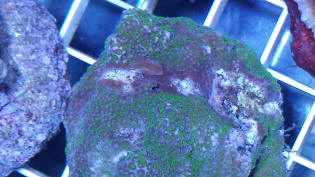
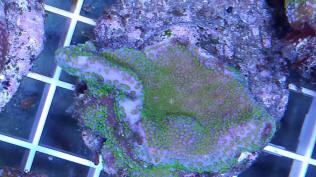 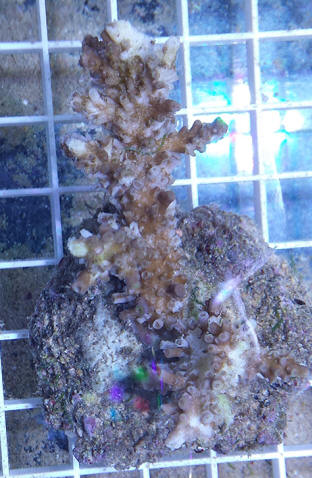 |
|
|
Coral Beauty... 16.5 megs of non-descript pix, no data, or
reading... Full moon?
12/11/14
Hi There, I had a couple of corals that looked like these
pictures.
<... they're dead, dying... evidently you have a "water quality
issue" or three... Too much nutrient, BGA et al. overgrowing... But, you
supply no data re>
The base of the frag would suddenly be white then it went up one side.
<Yes; bleached... dead>
When I was looking closely I could see some loose tissue thought it was
tissue necrosis. It seemed to occur only at night so I was thinking
sudden parameter change but nothing had changed. Then I thought maybe
flat worms.
so I purchased a six line wrasse. Well I was looking at a coral that did
not have any missing tissue and then I was looking at the tank and
suddenly there was some tissue missing one side by the base. Set back
and watched the Coral Beauty suddenly nip on the same side as the
missing tissue.
<Sometimes most Centropyges do nip Cnidarians>
I seen him nip at it a few times and the whole side of the frag had been
nipped clean. Now I have to get him out before he destroys all the
accros.
Know of any good ways other than taking most of the rock structure out.
<Yes; search WWM re... all gone over and over re traps, netting
techniques>
Not going to be fun as it is a 250 gallon tank. I will never put another
fish in the tank that maybe questionable as being reef safe.
Thanks Bruce
<Read WWM's requirements re writing us please. Bob
Fenner>
|

 |
|
Re: Coral Beauty
12/12/14
Hi Bob,
Bruce Here
<Heya>
Sorry about the size of the photos, did not realize the size of them from my
cell phone.
I believe you answered my question on the corals and even the fact that the
Coral Beauty Angel is picking when it was not before.
<Ahh!>
Data for tank
250 gallon display tank 72 x 26 x 30, 125 gallon sump, over flows at both ends
of display tank, two Aqua C, EV-240 skimmers at each end of sump. About 200
pounds of rock from previous tank plus one large flat piece to seed old rock.
There is total water volume of 300 gallons in system. Tank has gone thru cycle
all hair algae and cyno is gone. Only have thin hard green algae growing in
places and some purple coralline growing on bottom and a few rocks. Fish in tank
Kole Tang, Two Yellow Tangs, Tomini Tang, Coral Beauty, Dart fire fish, six line
wrasse.
Lighting is by 2 Orphek Atlantiks, using led is new to me. Granulated carbon
reactor, gfo reactor, biopellet reactor
S.G. 1.025 digital refractometer
PH 8.32
Temp 79.8 morning 81.2 nights
Calcium 420
Alkalinity 8.74 dKH
magnesium 1480
Phosphate .07
Nitrates are a bit high around 50
<Yeeikes; this is much more than a bit... s/b under 10 ppm for a reef>
Biopellet reactor added about 2 weeks ago.
<Do you have a carbon deficiency?>
Moved lights up about 6 inches as the spread was not enough and at the same time
the program was changed to less light. I think the lighting is the problem as
some of the corals started turning brown.
<Mmmm; can you move them up on the rock, closer to the light?>
I have had 4 corals that this has happened to and 2 of them so far are surviving
and look like they may be getting back some color and growing. To many changes
on an immature tank and coral stress.
<Yes, too. Review Scleractinian care on WWM please. BobF> |
LPS/Open Brain Troubleshooting Question
11/28/14
Happy Holidays WMM Crew!
<And you Brad>
First off, I'm happy to report per the Ick/Velvet outbreaks I had in my
new Angle butterfly tank about 9 months ago, all is well and has been
stable since I used Chloroquine to clear everything up! Thanks again for
the guidance, the fish are stunning and have settled right in.
<Ah welcome>
Today I have a question regarding my other tank, which is a 270 Reef
tank that has been running for about 4 years now. The issue that I've
been noticing for some time is that my open brain corals (Welso's, Tracs,
Fungia plate corals &c) become significantly shriveled once I bring them
home from LFS's and stay that way. They might be incredibly puffy/meaty
at the store, but at home (say even after a few weeks) they are not as
lively. They don't die, recede, or bleach, they just don't
expand and look as stunning as they do in the shops.
<A few possibilities.... lighting, water quality (something too much
and/or too little), or the usual allelopathy>
A few words on my setup. So this is a 270G Display (80Lx30Hx26D) with
100G fuge, 8 AI Sol lights, 2 MP 40's, powerful Reef Dynamic Skimmer,
and I am running biopellets and GFO.
<Ahh... the middle of the potentials above. DO you have measurable NO3
and HPO4? NEED these>
The LPS are at various spots on or
near the sand, they are far away from other corals, and none of my
fish/inverts bother them. I feed phyto
<Almost nothing, and none of the stony corals listed, eat/use this>
and meatier foods (target) usually twice a week. I also have a
ton of SPS, Zoanthids, cloves, and other encrusting corals throughout
the tank. Everyone else has been doing spectacular for years, strong
growth, bright colors &c.
<Oh! Then not a nutrient issue>
I just can't figure out why the open brains don't seem to like my tank.
Even when I feed I don't get much of a response from them.
<Back to the allelopathy>
A few notes on the parameters. Phosphates are nearly undetectable,
Nitrates are <10, Salinity is 1.025, Alk is around 9, Calcium 420, Mag
1300. PH is between 8.1-8.3 throughout the night/date. The flow doesn't
seem strong at all down by the LPS, I have some xenia near by and they
aren't being pushed around much. I've even tried putting them in my fuge
but that had no impact (or turning down the powerhead.) In terms
of light, my par meter says they are getting around 150 max, which seems
to be in their happy range.
<Yes; plenty>
The stores in my area have them between 60-90, but even when I've tried
moving them into that range it has no impact. I do 40 gallon water
changes usually once a week, and I dose Iodine and occasionally
strontium. I'm using Seachem Salinity for Salt, and RODI water with 0
TDS.
<Fine>
So I feel like I've exhausted all of my know how on this and couldn't
find a clear answer from research. A few things that I was wondering if
it would have any impact would be 1) the GFO?
<Possibly>
Not sure if it could be dusty and the LPS not liking it? I also don't
run any mechanical filtration (just protein skimmer) because it clogs so
easily. I was thinking about putting a filter sock on the GFO effluent
and filter pad in front of my return pump for a few days, but I know the
latter will clog quick so I can't do it long term. The other thing I was
wondering is if it could be from using the biopellets?
I'm using the Reef Dynamics reactor and it's plumbed right into my
skimmer. Just seems like a variable between my tank and the LFS'.
<Try removing one or both of these for a few weeks to see>
I was told my water could be too clean, but given that I have a ton of
fish in my reef and I feed heavily I find that hard to believe. Anyhow,
was wondering if you had any suggestions or could better point me in the
right direction? I'm considering sending off my water to a lab company
to have them test it, but no sure If that will provide much value, or
just be interesting to know.
As always I greatly appreciate your help! Hope you and yours have a
wonderful holiday season!
Brad
<Am asking that you read here:
http://wetwebmedia.com/CorlCompArt.htm
and as much of the linked files above as to gain insight... And possibly
try a couple units of Chemipure in your filter flow path... and, really,
consider moving the mal-affected LPS elsewhere for a while to discount
the poss. that they're being influenced by the Zoanthids, Xenia... Bob
Fenner>
Re: LPS/Open Brain Troubleshooting Question
11/29/14
Thanks Bob for the lightning fast response over the holidays no less!
<I work every day the sun comes up!>
A few quick responses.
1. There are detectable levels of Nitrate and Phosphate, between 5-10ppm
of Nitrate and maybe .03 of phosphate. I would imagine more than enough
of what they need.
<Ah good; yes>
2. Your suggestion of allelopathy certainly intrigues me. I
didn't think that would be a problem given the distance between the
brains and the SPS.
<Not the SPS that are trouble>
I know that some corals like leathers can shed (which I don't have any)
but I thought as long as they were not in proximity (including
sweeper tentacles) it should be fine.
<Ah no... Zoanthids, Corallimorpharians, Gorgonaceans... many species
are chemical warfarers>
What's the best way to test this hypothesis?
<Selective removal of suspected perpetrators, mal-affecteds>
Would running carbon or ozone help?
<Yes... a high and steady ORP (low 400s) would be great>
I guess I could remove the corals--unfortunately I can't put the open
brains in my angel tank :) so I might need to find them a new home.
3. Do you think having a relatively heavy bioload could impact them?
<Not negatively; no... many of these species live in the mud, muck in
the wild>
I do have a lot of fish and feed somewhat heavily, but I do compensate
with powerful skimming and water changes (and as mentioned, I have lie
15 different kinds of SPS/Acros and those are happy.)
Thanks again for your guidance and suggestions, no urgency on a
response, please enjoy your Thanksgiving!
Best Regards,
Brad
<And you! BobF>
|
|

